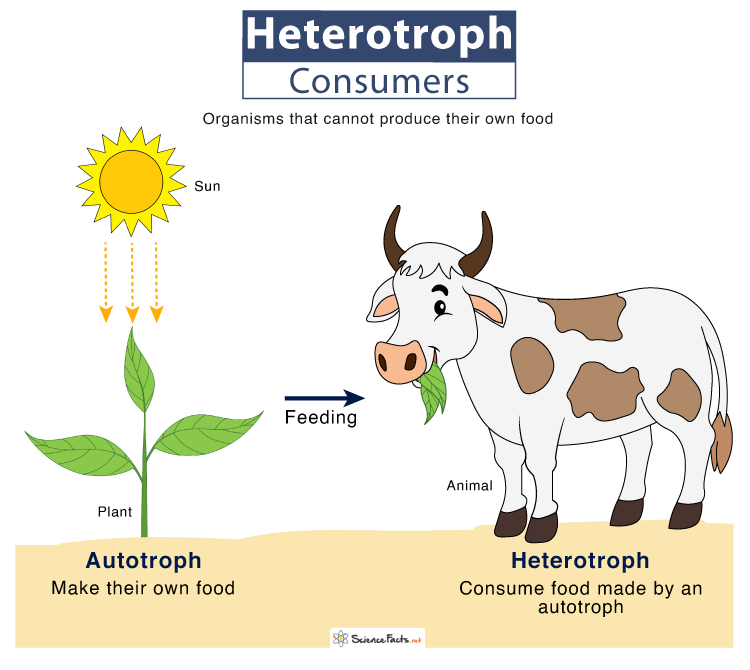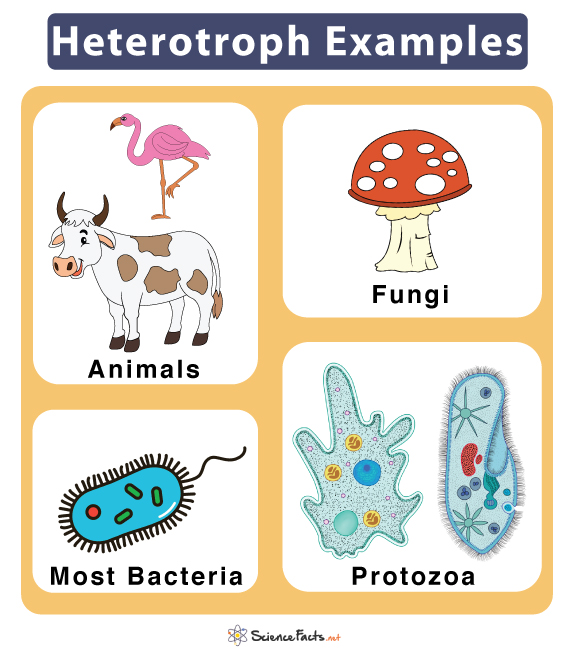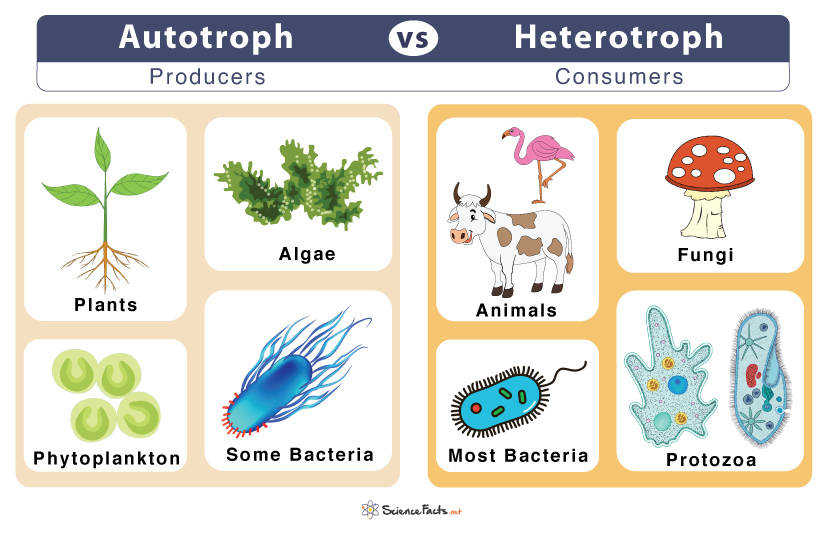Heterotroph
‘Hetero’ means other, and ‘trophe’ means ‘nourishment. A heterotroph is an organism that depends on other organisms for food and energy. These other organisms are known as autotrophs (primary producers). Unlike autotrophs, they cannot prepare their food from inorganic molecules. Thus, heterotrophs are also called consumers.
All members of kingdom Animalia are heterotrophs, including dogs, cats, squirrels, rabbits, mice, lions, and leopards. Some plants, such as Venus flytrap and pitcher plants, are also heterotrophs as they feed on insects for their food. Also, many microorganisms, including bacteria and fungi, and some protists, exhibit a heterotrophic mode of nutrition.
Heterotrophs occupy the second and third trophic levels in a food chain after the first level consisting of autotrophs.
Types of Heterotrophs
Based on Food Habits
Heterotrophs are primarily classified into four different types based on their food habit and presence in the food chain. They are herbivores, carnivores, omnivores, and detritivores.
1. Herbivores feed on autotrophs like plants and algae for food. Herbivores occupy the second trophic level of the food chain.
Examples: Deer, cow, and buffalo
2. Carnivores eat meat and feed on herbivores, thus called primary consumers. Carnivores inhabit the third trophic level of the food chain.
Examples: Tiger, wolf, and crocodile
3. Omnivores: They eat both plants (autotrophs) and meat (herbivores and carnivores) and are thus called secondary consumers. Similar to carnivores, omnivores also occupy the third trophic level of the food chain.
Examples: Humans, bears, and foxes
4. Detritivores (Decomposers) feed on the remains of plants and animals and fecal matter. Detritivores help to clean the ecosystem and keep them healthy.
Examples: Bacteria, fungi, worms, and insects
Based on Energy Source
Heterotrophs are also sometimes classified based on their energy source into two types. They are photoheterotrophs and chemoheterotrophs.
a. Photoheterotrophs get their energy from light. They, however, obtain carbon from other organisms as they cannot utilize carbon dioxide directly from the atmosphere.
Examples: Purple non-sulfur bacteria, green non-sulfur bacteria, and heliobacteria
b. Chemoheterotrophs get both light and carbon from other organisms. They cannot utilize light and carbon dioxide from the atmosphere.
Examples: Bacteria and archaebacteria in deep-sea vents and volcanoes
Autotroph vs. Heterotroph
Autotrophs and heterotrophs have many differences with some similarities.
Differences
| Basis | Autotroph | Heterotroph |
|---|---|---|
| 1. Produce own food | Yes. | No. |
| 2. Examples | Plant, algae, and autotrophic bacteria | All animals, including humans, parasitic plants, fungi, protists, and heterotrophic bacteria |
| 3. Source of energy | Sunlight or chemical reactions | Autotrophs |
| 4. Trophic level in the food chain | Exist in the first trophic level of the food chain. | Exist in the second and third trophic levels of the food chain. |
| 5. Role in the food chain | Producer | Consumer |
| 6. Photosynthesis | Perform photosynthesis to produce their food | Cannot perform photosynthesis |
| 7. Carbon Source | Use inorganic carbon as the carbon source | Use organic carbon as the carbon source |
| 8. Types | They are of two types: 1) photoautotrophs and 2) chemoautotrophs | They are also of two types: 1) phytotoheterotrophs and 2) chemoheterotrophs |
| 9. Dependent | They are independent as they can produce their food and thus are also called ‘self-feeders’ | They are dependent on autotrophs for food and thus are also called ‘other-eaters’ |
Similarities
Both are:
- Living things and thus need food and energy to survive
- Can reproduce
- Respond to the environment and maintain homeostasis
- In need of carbon source (inorganic or organic)
- Made of cells
- Part of the ecosystem and food chain of the biosphere
The key differences and similarities between an autotroph and a heterotroph are shown using a Venn diagram.
FAQs
Ans. Eubacteria (true bacteria) perform both autotrophic and heterotrophic modes of nutrition.
Ans. All protists, including amoeba and paramecium, perform heterotrophic mode of nutrition.
Ans. Yeasts are fungi and, thus, perform heterotrophic mode of nutrition.
Ans. Yes, since mushrooms cannot perform photosynthesis and depend on dead organic matter for food, they are heterotrophs.
Ans. Heterotrophs get oxygen from photosynthesis, which is a byproduct of the process. Also, photosynthesis sustains the autotrophs that heterotrophs use as food. Although secondary consumers may not directly depend on autotrophs to survive, they depend on primary consumers as a food source.
-
References
Article was last reviewed on Friday, February 17, 2023







